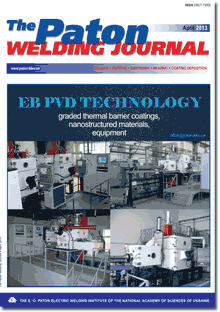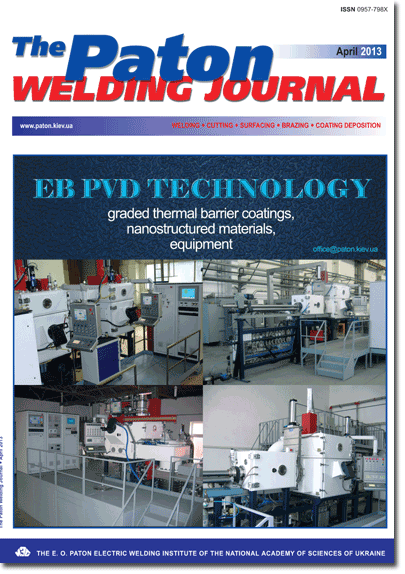| 2013 №04 (04) | 2013 №04 (06) |

The Paton Welding Journal, 2013, #4, 26-33 pages
STUDY ON THE EFFECT OF INDUCTION HEATING TO PREVENT HOT CRACKING DURING LASER WELDING OF ALUMINUM ALLOYS
V.V. SOMONOV1, S. BOEHM2, M. GEYER2 and S. BERTELSBECK2
1Institute of Laser and Welding Technologies of Saint-Petersburg State Polytechnical University, Saint-Petersburg, Russia
2University of Kassel, Witzenhausen
Abstract
This work is devoted to research of hot spots generated by induction heating to prevent hot cracks during laser welding of Al-Mg-Si and Al-Si aluminum alloy samples 2 mm thick. The results of numerical modeling of temperature fields and stress fields formed during the process of induction heating, as well as results of experimental validation of the simulation are shown. 25 Ref., 3 Tables, 10 Figures.
Keywords: laser welding, induction heating, aluminum alloys, modeling, SYSWELD, thermal stresses, hot cracks
Received: 12.03.13
Published: 28.04.13
References
1. Lang, A. (1997) Schweissen von Aluminiumwerkstoffen im Fahrzeugbau. In: Jahrbuch Schweisstechnik.
2. Ostermann, F. (2007) Anwendungstechnologie Aluminium. Berlin; Heidelberg: Springer.
3. Cam, G., dos Santos, J.F., Kocak, M. (1997) Laser and electron beam welding of Al-alloys: Rev. Geesthacht: GKSS-Forschungszentrum.
4. Brune, E. (2005) Schweisser Maschinenmarkt. Schweissen von Aluminiumwerkstoffen, 106(25/26).
5. Thomy, C., Seefeld, T., Vollertsen, F. (2005) Schweissen mit Hochleistungsfaserlasern. Werkstatttechnik, 10, 815-820.
6. Ploshikhin, V. et al. (2005) Integrated mechanical-metallurgical approach to modeling solidification cracking in welds. In: Hot cracking phenomena in welds. Berlin: Springer.
7. Clyne, T.W., Davies, G.J. (1981) The influence of composition on solidification cracking susceptibility in binary alloy systems. British Foundry, 74, 65.
8. Feurer, U. (1977) Influence of alloy composition and solidification conditions on dendrite arm spacing, feeding and hot tearing properties of aluminum alloys. In: Proc. of Int. Symp. on Engineering Alloys (Delft, The Netherlands), 131-145.
9. Piwonka, T.S., Flemings, M.C. (1966) Pore formation in solidification. Transact. of Metallurg. Soc. of AIME, 236, 1157.
10. Prokhorov, N.N. (1952) Hot cracking during welding. Moscow: Mashgiz.
11. Bochvar, A.A., Rykalin, N.N., Prokhorov, N.N. et al. (1960) On problem of «hot» (crystallization) cracks. Svarochn. Proizvodstvo, 10, 5-7.
12. Prokhorov, N.N. (1962) Technological strength of metals at crystallization during welding. Ibid., 4, 1-8.
13. Rappaz, M., Drezet, J.-M., Gremaud, M. (1999) A new hot-tearing criterion. Metallurg. and Materials Transact. A, 30, 449-455.
14. Coniglio, N. (2008) Aluminum alloy weldability: Identification of weld solidification cracking mechanisms through novel experimental technique and model development: BAM-Diss.Berlin.
15. Shibahara, M., Serizawa, H., Murakawa, H. (2000) Finite element method for hot cracking analysis under welding using temperature-dependent interface element. In: Modeling of casting, welding and advanced solidification processes IX. Aachen: Shaker, 844-851.
16. Shibahara, M., Serizawa, H., Murakawa, H. (2001) Finite element method for hot cracking analysis using temperature-dependent interface element. In: Mathematical modeling of weld phenomena 5. London: IOM Commun., 253-267.
17. Bergmann, H.W., Hilbinger, R.M. (1998) Numerical simulation of centreline hot cracks in laser beam welding of aluminum close to the sheet edge. In: Mathematical modeling of weld phenomena 4. London: IOM Commun., 658-668.
18. Hilbinger, R.M., Bergmann, H.W., Koehler, W. et al. (2001) Considering of dynamic mechanical boundary conditions in the characterization of a hot cracking test by means of numerical simulation. In: Mathematical modeling of weld phenomena 5. London: IOM Commun., 847-862.
19. Hilbinger, R.M. (2000) Heissrissbildung beim Schweissen von Aluminium in Blechrandlage. Bayreuth: Universitaet Bayreuth.
20. Vasiliev, V.I., Illiashchenko, D.P., Pavlov, N.V. (2010) Introduction to fundamentals of welding. Tomsk: TPU.
21. Lindenau, D. (2007) Magnetisch beeinflusstes Laserstrahlschweissen: Diss. Stuttgart.
22. Goebel, G. (2007) Erweiterung der Prozessgrenzen beim Laserstrahlschweissen heissrissgefsshrdeter Werkstoffe: Diss. Dresden.
23. Rapoport, E.Ya. (1993) Optimization of processes of induction heating of metal. Moscow: Metallurgiya.
24. Grigoriants, A.G., Shiganov, I.N., Chirkov, A.M. (2004) Hybrid laser welding technology: Handbook. Moscow: N.E. Bauman MGTU.
25. Korshikov, S.E., Zaikina, N.V., Rybalko, G.S. (2010) Simulation of temperature fields and thermal stresses during heating of aluminum billets rotated in the direct current magnetic field. In: Bull. of Samara STU, 2.
Suggested Citation
V.V. SOMONOV1, S. BOEHM2, M. GEYER2 and S. BERTELSBECK2 (2013) STUDY ON THE EFFECT OF INDUCTION HEATING TO PREVENT HOT CRACKING DURING LASER WELDING OF ALUMINUM ALLOYS. The Paton Welding J., 04, 26-33.The cost of subscription/purchase order journals or individual articles
| Journal/Currency | Annual Set | 1 issue printed |
1 issue |
one article |
| TPWJ/USD | 384 $ | 32 $ | 26 $ | 13 $ |
| TPWJ/EUR | 348 € | 29 € | 24 € | 12 € |
| TPWJ/UAH | 7200 UAH | 600 UAH | 600 UAH | 280 UAH |
| AS/UAH | 1800 UAH | 300 UAH | 300 UAH | 150 UAH |
| AS/USD | 192 $ | 32 $ | 26 $ | 13 $ |
| AS/EUR | 180 € | 30 € | 25 € | 12 € |
| SEM/UAH | 1200 UAH | 300 UAH | 300 UAH | 150 UAH |
| SEM/USD | 128 $ | 32 $ | 26 $ | 13 $ |
| SEM/EUR | 120 € | 30 € | 25 € | 12 € |
| TDNK/UAH | 1200 UAH | 300 UAH | 300 UAH | 150 UAH |
| TDNK/USD | 128 $ | 32 $ | 26 $ | 13 $ |
| TDNK/EUR | 120 € | 30 € | 25 € | 15 € |
AS = «Automatic Welding» - 6 issues per year;
TPWJ = «PATON WELDING JOURNAL» - 12 issues per year;
SEM = «Electrometallurgy Today» - 4 issues per year;
TDNK = «Technical Diagnostics and Non-Destructive Testing» - 4 issues per year.


